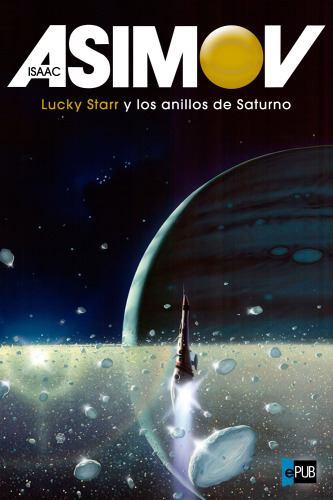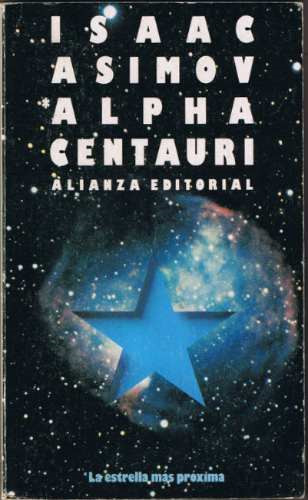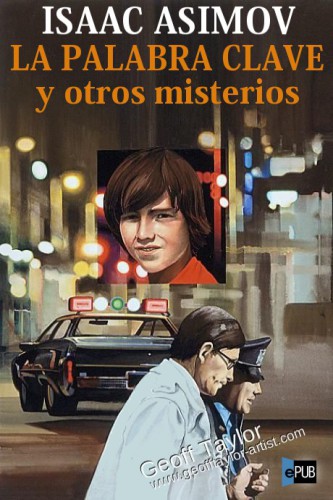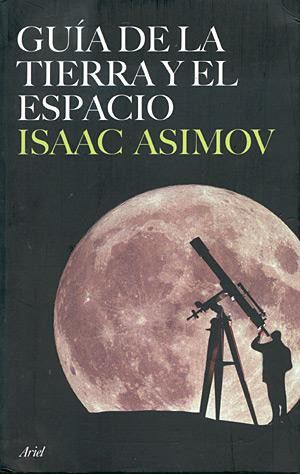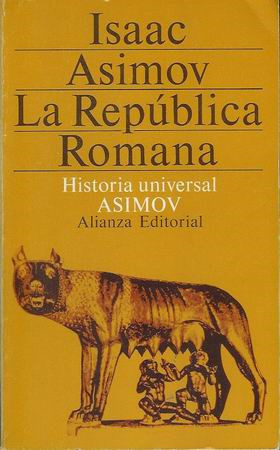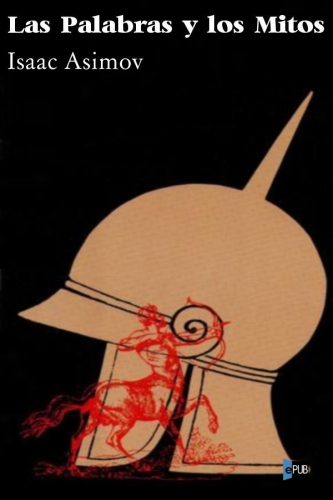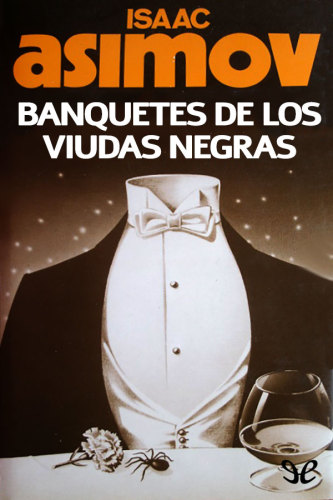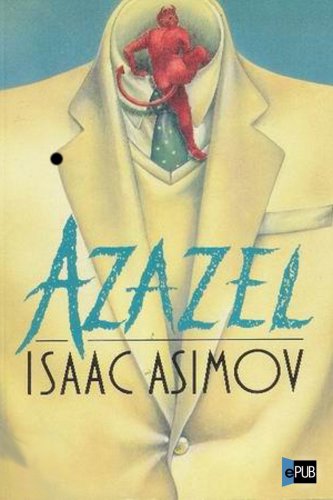oleebook.com
¿Hay alguien ahí? de Asimov, Isaac
de Asimov, Isaac - Género: Ficcion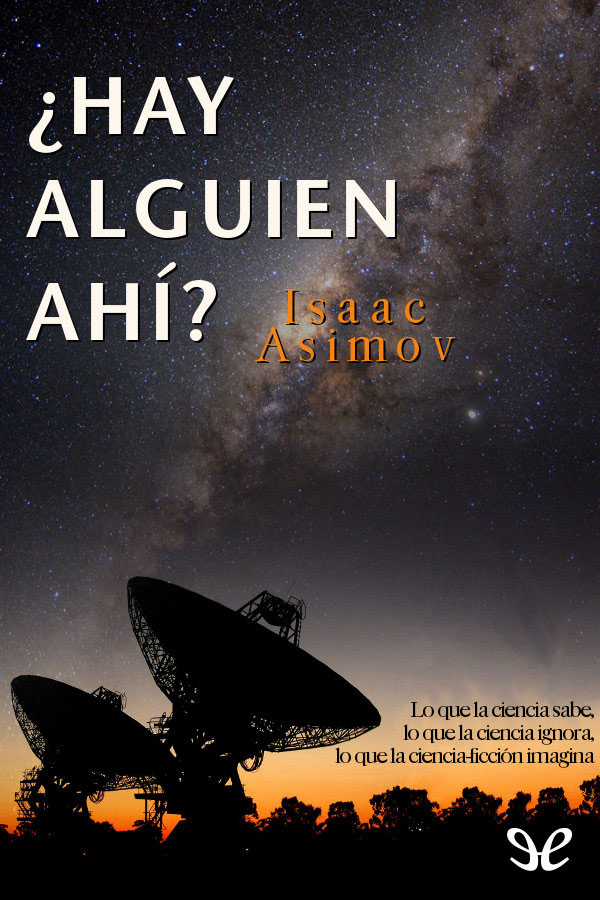
Sinopsis
El proverbial talento divulgador de Isaac Asimov se pone de manifiesto una vez más en este volumen misceláneo, que presenta una rica variedad de ensayos hilvanados antes que nada por la extraordinaria curiosidad del autor. Desde el funcionamiento del cerebro hasta los viajes en el tiempo y el futuro del Universo, muchas son en efecto las cuestiones que Asimov aborda en estas páginas. Pero si hay un tema que sobresale en esta variopinta colección, éste es el de la vida extraterrestre y sus posibilidades de existencia. ¿Hay alguien ahí, en algún lugar de los inmensos espacios del Universo, dotado de inteligencia y con el cual se pueda establecer algún tipo de comunicación? Sea cual sea la respuesta, lo cierto es que ésta desde hace años ha dejado de pertenecer ya al ámbito puramente imaginario de la ciencia-ficción.
Descargar
Descargar ¿Hay alguien ahí? ePub GratisLibros Recomendados - Relacionados
Reseñas Varias sobre este libro
My copy is so old it is browning and the most of the pages are held together by static. I reread it from time to time to remind myself what was anticipated so many years ago. It is refreshing to see how close his thoughts came to so much of what has actually transpired. While there are several areas where the book is off base, some areas are still valid for the future. This book was one of those that shaped my way of thinking growing up. It is an old friend and every time I pick it up it reminds me of times and conversations that I treasure to this day.3 s Luis Javier Capote PérezAuthor 1 book6
Una obra de divulgación en la que su autor, célebre por sus obras en el campo de la ciencia-ficción, da un repaso divulgador de la historia de la vida, al tiempo que atisba un posible futuro, vinculado al estado de las cosas en el momento de la elaboración de este libro. Algunos capítulos son ensayos en torno a dilemas vistos en sus trabajos de ficción. Por su parte, todo el conjunto es un ameno repaso por un ejercicio de futurología (desprovista de su carga magufa) en el que hay aciertos, desaciertos y temas aún y siempre vigentes.1 Robu-sensei369 23
This collection of short essaysfully 37 articles averaging merely eight pages eachis an excellent starting point for anyone interested in general science but fearful of long-winded, dry or overly technical writing. Asimov writes clearly and simply, engaging the reader with his expertise on practically any subject. Un most of his essay compilations, Is Anyone There? is not distilled from Asimov's column in The Magazine of Fantasy and Science Fiction, but rather from various periodicals (including Mademoiselle!), lectures and papers.
Also atypical is the large proportion of speculation: in the second section "Concerning the More or Less Unknown," seven essays are devoted entirely to predicting some aspect of the future, and five more concern extraterrestrial life. Regrettably, Asimov's vision of the future, as sampled in these works, seems far too optimistic. Intriguingly, he hits much closer to the mark extrapolating from current knowledge in the beginning section, "Concerning the More or Less Known."
Several essays stand out as highly memorable (ironically, I include this list to help me remember them). "A Pinch of Life" is at its core a simple catalog of the essential elements of the human body, arranged in decreasing order of proportion of the total atoms. How Asimov manages to make this interesting eludes me, but somehow he does. "The Ocean Mine" does the same for the contents of the ocean (did you know that our oceans contain six million tons of gold?). In "The Cult of Ignorance," the Good Doctor decries American anti-intellectualismone year before the Soviet Union launched Sputnik I. Finally, "Constructing a Man" magnificently summarizes the mechanics of modern DNA technology, fifteen years before the Human Genome Project was even conceived.2007 asimov general-science1 Matias181 20
I always enjoy reading Asimov´s essays on various topics, so this was really intresting for me. The chapters I enjoyed the most were "The Cult of Ignorance" and "The Sword of Aquilles", which surprised me because of the topics involved.1 G. Branden131 53
Starts off strong, then flags (progressively) after about the halfway mark.
Some of my impression may be due to personal bias in favor of Asimov essays wherein he explains scientific, mathematical, or historical fact; essays of this type comprise the first part of this collection ("Concerning the More or Less Known", about half of the book's total length).
All of the essays in this part are solid; they are divided into two sections, "Life", consisting of nine essays on mostly biochemical subjects, and "Nonlife", ten on inorganic chemistry, physics, and astronomy. The opening two entries provide an intriguing look at what must have been close to the state of the art in neuropsychology and genetics at the time. These essays pretty closely resemble Asimov's essays for The Magazine of Fantasy and Science Fiction at the time, and as I enjoy those tremendously, I found them comfortable and illuminating.
[Aside: I should note in particular Chapter 13, "Our Evolving Atmosphere" (am I the only person for whom such titles resurrect horrific memories of primary school textbook pabulum?), published in 1966 for the science annual of the World Book Encyclopedia spoke frankly about the greenhouse-gas consequences of massive carbon dioxide releases into the atmosphere as a result of human activities. I mention this because Asimov is popularly derided in the online global warming "debate" as having been a "global cooling" doomsayer in the 1970s.]
By contrast, the second part ("Concerning the More or Less Unknown") is a collection of more speculative fare. Its first section is "Other Life", which is tolerable, but the title essay of the book, and best entry in the section, "Is Anyone There?", treats techniques of communicating with extraterrestrial civilizations and suffers by comparison to Carl Sagan's later work on the same subject. (For the curious, the two radio sources, CTA-21 and CTA-102, for which Asimov held out hopes--"highly unly" ones, as he put it--as beacons constructed by extraterrestrial intelligences appear to have faded almost completely in notoriety, but continue to be studied as examples of "Gigahertz Peaked Spectrum" radio sources.)
The second half of part two, "Future Life", is, I'm sad to say, mostly a fairly dull effort at prognostication. Some of that may be inevitable, though, as the first two essays, "The World of 1990" and "The World's Fair of 2014", are inescapably going to read dramatically differently to a person in 2009 than to Asimov's original audience (or even the one that picked up "This Ace Printing: August 1980", per the copyright page). The last essay in the section, the prosaically titled "The Universe and the Future", is one of the longest essays in the book and is an extended consideration of what it will mean to undertake human--and post-human--exploration of the cosmos given currently-known limitations. The worst thing about the essay is the author's coinage of the ugly term "spome" (whose etymology he deliberately withholds until near the end), and while this is a superficial gripe, the ubiquity of its use makes it grate. As a significantly positive counterbalancing factor, Asimov does not even mention superluminal travel, wormholes, or hyperspace, and his omission of these currently-thought-impossible technologies consequences on interstellar exploration are sobering but strangely fresh, given that science fiction--at least the proletarian varieties within my limited horizons--tend to stipulate one or more of these (or, Kim Stanley Robinson's Mars Trilogy, are set near enough to us in time and space that they need not be confabulated).
The final six essays (of thirty-seven total) compose the final part, "Concerning Science Fiction", and are the weakest of all, with the penultimate and antipenultimate entries being tongue-in-cheek of then-contemporary television science fiction programming. That said, the last essay "The Lovely Lost Landscapes of Luna" is more thoughtful and somewhat redemptive--as Asimov grew from youth to middle age, from avid reader of Burroughs's John Carter of Mars books to scientifically-educated follower of the Mariner program, he watched the remote plausibility of early SF evaporate altogether, and the essay serves as a kind of eulogy for an age of lost innocence and (blissful?) ignorance. Asimov's enthusiasm for actual science fact, so effectively communicated in the first part of the book, contextualizes his wistfulness and makes it palatable to readers who ( Asimov) are easily irritated by know-nothingism (also see Chapter 33, "The Cult of Ignorance").
Bottom line: If you're a big, big fan of Asimov's nonfiction, read the first half and possibly chapters 31 and 37. Non-Asimovophiles will probably want to skip this entirely.
Contents:
I. Concerning the More or Less Known
A. Life
1. Matter over Mind ("That Odd Chemical Complex, The Human Mind"; The New York Times Magazine, 1966-07-03)
2. I Remember, I Remember ("Pills to Help Us Remember?"; The New York Times Magazine, 1966-10-09)
3. The Hungry People (Mademoiselle, 1960-10)
4. Blood Will Tell (Think, 1962-02)
5. The Chemical You (Mademoiselle, 1963-01)
6. Survival of the Molecular Fittest ("The New Enzymology", Consultant, 1965-05)
7. Enzymes and Metaphor (Journal of Chemical Education, 1959-11)
8. A Pinch of Life (Science World, 1957-03-05)
9. Constructing a Man ("Conceived in the Love Bed of Science"; True, 1966-02)
B. Nonlife
10. The Flaming Element (Petroleum Today, Winter 1961/1962)
11. Let There Be a New Light (no original publication information)
12. The Ocean Mine (Science World, 1957-03-19)
13. Our Evolving Atmosphere (Science Year--The World Book Science Annual, 1966)
14. The Atmosphere of the Moon (Venture Science Fiction, 1958-03)
15. Man and the Sun (no original publication information)
16. The Unused Stars (Amazing Stories, 1959-07)
17. Measuring Rods in Space (Space World 1961-09)
18. Time-Travel: One-Way (The North American Review, Summer 1964)
19. The Birth and Death of the Universe ("Over the Edge of the Universe"; Harper's Magazine, 1967-03)
II. Concerning the More or Less Unknown
A. Other Life
20. A Science in Search of a Subject (The New York Times Magazine, 1965-05-23)
21. We, the In-Betweens (Mademoiselle, 1961-05)
22. Is Anyone There? ("Hello, CTA-21--Is Anyone There?"; The New York Times Magazine, 1964-11-29)
23. Anatomy of a Martian ("Anatomy of a Man from Mars"; Esquire Magazine, 1965-09)
24. On Flying Saucers (original to this collection)
B. Future Life
25. The World of 1990 (The Diners' Club Magazine, 1965-01)
26. The World's Fair of 2014 ("Visit to the World's Fair of 2014", The New York Times Magazine, 1964-08-16)
27. Fecundity Limited (Venture Science Fiction, 1958-01)
28. The Price of Life (Cavalier, 1967-01)
29. The Moon and the Future ("What Can We Expect of the Moon?"; The American Legion Magazine, 1965-03)
30. The Solar System and the Future ("How Far Will We Go in Space?"; The World Book Year Book, 1966)
31. The Universe and the Future ("There's No Place Spome"; Atmosphere in Space Cabins and Closed Environments, 1966)
III. Concerning Science Fiction
32. Escape into Reality (The Humanist, 1957-11/12)
33. The Cult of Ignorance ("The By-Product of Science Fiction"; Chemical and Engineering News, 1956-08-13)
34. The Sword of Achilles (Bulletin of the Atomic Scientists, 1963-11)
35. How Not to Build a Robot ("Why I Wouldn't Have Done It This Way"; TV Guide, 1965-01-16)
36. The Insidious Uncle Martin ("Can You Spot the Family Resemblance?"; TV Guide, 1966-03-05)
37. The Lovely Lost Landscapes of Luna (P.S., 1966-04) José Manuel7
Imagino que son los años que tiene... no me ha gustado demasiado, muy repetitivo y pedante. Liedzeit LiedzeitAuthor 1 book79
Enzymes and Metaphor ist ziemlich gut. Viel von dem Rest ist natürlich sehr veraltet. 7/10asimov science George Ronczy42 1 follower
An interesting read, especially around predictions of what life would be in 50-75 years, i.e. now. Some hits, some misses. Asimov's concise writing keeps in readable. Remo2,324 148
Diez años de ensayos y artículos variados de Asimov, publicados en multitud de revistas. Hay de todo, desde divulgación clásica sobre el funcionamiento del cerebro o la detección de vida extraterrestre hasta predicciones del futuro (Asimov no vio venir Internet claramente), pasando por ensayos sobre el presente y el futuro de la ciencia ficción. La parte divulgativa es, como siempre, excepcional. Daba gusto leer al viejo maestro, quien, como único fallo, no desperdiciaba ni una sola oportunidad de quererse en publico. En conjunto, un volumen para aprender un montón de cosas interesantes, aunque hoy muchos de los ensayos ya se hayan quedado antiguos (las predicciones para dentro de 50 años hechas en 1950, etc etc). Pero muy recomendable, aun así.1997 astronomia ciencia-ficcion ...more Jen Mays70 2
A collection of essays written by Asimov for an assortment of publications is compiled into this single volume, and span a writing period of about a decade, mid 1950s-60s. Sectioned into themes, the essays cover science from the inside out, starting with such topics as atoms and the biological makeup of a human being, and ending with speculation about where humanity is going beyond Earth. The book is at once both dated and timeless.
There were aspects of the book that were too technical for my brain; while I could see them being appealing for those that are math or science-detail minded, the occasionally long lists of "parts per billionth" of whatever was being discussed caused me to yawn and skim. However, even if some of these info bits were not my cuppa, I appreciated their presence in the collection because they contributed to the building toward the final essays which were (by necessity) based on supposition.
My favorite bits were the later sections, which included and essay of Asimov's thoughts on what life would be for humans in 1990. It was both entertaining and amusing to read some ideas laid out with such accuracy in terms of how the future did develop, combined with ideas that are still so out of our range. Science and technology developments in some ways happened exactly as he imagined, while others (such as establishing a base on Pluto by 1985) seem so farfetched they still exist mostly as science-fiction/fantasy.
Asimov's thoughts on space exploration were of special interest to me since that tends to be where a lot of my fascination lies. It made me both excited to imagine the possibilities, but also, as I recalled the images of the space shuttles on their final flights, really sad that we seem to have closed that chapter in our exploration, at least for now. I hope it's a chapter that is re-opened sooner rather than later. MarieAuthor 66 books100
A collection of essays. There's some repetition and some dated science - which is part of the fun, really. I read a good handful of these when I was young and I find that:
1. Wow, Asimov was a letch. i mean, am I right? Every time he needs an example, his default joke is "for example, you could be trying to hold your best girl" "for example, a pretty girl could walk by." :P
2. I miss optimism in SF.
The science articles in the first two thirds of the book are very basic, suitable to a teen audience, dated, but clear and quick in Asimov's simple style. The last section, where he talks about Science Fiction itself, is the only part I would be ly to read again. Ana29 5
Es de los poco libros de ciencia que he tenido la oportunidad de leer, se enfoca mucho en el funcionamiento del cerebro humano, la mente y el comportamiento de las personas visto desde un punto de vista científico.
Todo el libro es MUY interesante, jamás llega a ser tedioso, más bien es sorprendente. JimAuthor 7 books2,050
Quite dated now, there are still some interesting points brought up. His writing is easy for a layman to understand.1paper 2non-fiction 3short-stories Andre199 4
I was impressed by this book. Asimov is fabulous and he knew so much before anyone else. Jimmy Head64 1 follower
Humorous time travel back 40 years.bookstore-recycle-bin futuristic-from-the-past Shan661 38 Read
Autor del comentario:
=================================
